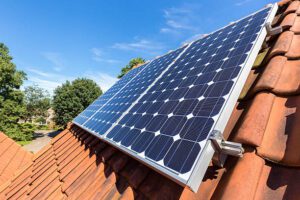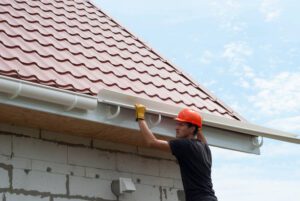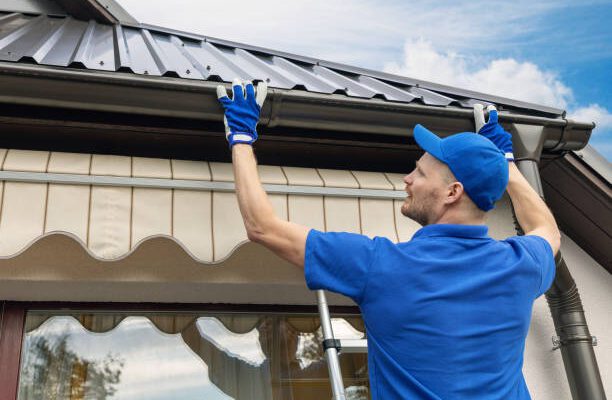In an era where environmental concerns are at the forefront of decision-making, the choice of a roof system holds significant weight in determining the sustainability of a building. A sustainable roof system not only reduces a building’s environmental impact but also enhances energy efficiency, indoor comfort, and overall longevity. This article aims to provide a comprehensive guide to selecting a sustainable roof system, covering essential considerations, available options, and the benefits of making an environmentally conscious choice.
Understanding Sustainable Roofing
Sustainable roofing goes beyond traditional considerations of aesthetics and functionality. Moreover, it encompasses a holistic approach that considers the entire lifecycle of the roof, from material sourcing and production to installation, maintenance, and eventual disposal. Key aspects of sustainable roofing include:
 (Photo from istock)
(Photo from istock)
- Energy Efficiency: A sustainable roof should have high thermal resistance (R-value) to minimize heat transfer between the interior and exterior, reducing the need for excessive heating and cooling.
- Durability and Longevity: Long-lasting roof systems minimize the need for frequent replacements, reducing resource consumption and waste generation over time.
- Material Selection: Sustainable roofing materials are often recycled, recyclable, or made from renewable resources. The use of locally sourced materials further reduces the environmental footprint.
- Reflectivity and Cool Roofs: Cool roofs with high solar reactance and thermal remittance reduce the urban heat island effect and lower cooling energy demand.
- Water Management: Proper drainage systems and rainwater harvesting features help manage water runoff effectively.
- Adaptability: A sustainable roof should be adaptable to future changes, such as the installation of solar panels or green roofing systems.
Factors to Consider When Selecting a Sustainable Roof System:
- Climate and Location: The local climate greatly influences the choice of roof system. For example, cool roofs are more beneficial in hot climates, while sloped roofs might be more appropriate for regions with heavy rainfall.
- Roof Slope and Design: Different roof slopes and designs require specific roofing materials. Some sustainable options are better suited for flat roofs, while others work best on steep slopes.
- Roofing Materials: Consider eco-friendly materials like metal, clay or concrete tiles, sustainable wood, recycled shingles, and synthetic membranes. Research the environmental impact of the chosen materials and their potential for recycling.
- Insulation: Adequate insulation improves energy efficiency and thermal comfort. Choose insulation materials with high R-values and minimal environmental impact.
- Cool Roof Options: Reflective and emissive materials can help reduce energy consumption by reflecting sunlight and heat away from the building.
- Green Roofing: In some cases, installing a living green roof with vegetation can provide natural insulation, reduce storm-water runoff, and contribute to local biodiversity.
- Solar Compatibility: If solar panels are a future consideration, ensure that the roof structure can support the additional weight and that the roofing material won’t hinder installation.
- Life Cycle Cost Analysis: Evaluate the long-term costs of the chosen roof system, factoring in installation, maintenance, energy savings, and potential replacements.
- Local Regulations and Incentives: Research local building codes, regulations, and potential incentives for installing sustainable roofing systems.
-
Installer Experience
Choose reputable contractors experienced in installing the chosen sustainable roof system to ensure proper installation and performance.
Types of Sustainable Roofing Systems:
- Metal Roofing: Metal roofs are durable, lightweight, and recyclable. They reflect sunlight, reducing heat absorption and cooling loads. Copper, aluminum, and steel are popular choices.
- Clay and Concrete Tiles: These tiles are made from natural materials, are long-lasting, and provide good thermal insulation. They are particularly suitable for warm climates.
- Slate Roofing: Slate is a natural stone that offers longevity and fire resistance. It’s durable and can be recycled, but it may have a higher upfront cost.
- Recycled Shingles: Made from materials like rubber, wood fiber, and plastic, recycled shingles are eco-friendly. And offer versatility in terms of style and color.
- Sustainable Wood Shingles and Shakes: Choose certified sustainably harvested wood to ensure responsible sourcing. Cedar and redwood are commonly used for their durability and natural appearance.
- Single-Ply Membranes: These synthetic materials, such as TPO (thermoplastic ole-fin) and PVC (polyvinyl chloride), are lightweight, reflective, and recyclable.
- Green Roofs: These living roofs are covered in vegetation, providing natural insulation, storm-water management, and improved air quality.
- Cool Roofs: Typically made from reflective materials, cool roofs reduce heat absorption, lower cooling costs, and extend the life of the roof.
Benefits of Selecting a Sustainable Roof System:
 (Photo from istock)
(Photo from istock)
- Energy Savings: A well-insulated and reflective roof can significantly reduce heating and cooling energy consumption, leading to lower utility bills.
- Environmental Impact: Sustainable roof systems minimize resource depletion. Waste generation, and carbon emissions associated with traditional roofing.
- Improved Indoor Comfort: Proper insulation and reduced heat transfer contribute to more consistent indoor temperatures. And enhanced occupant comfort.
- Longevity: Durable and high-quality sustainable roof systems have longer lifespans. Reducing the need for frequent replacements.
- Reduced Urban Heat Island Effect: Cool roofs reflect sunlight and heat away from buildings. Helping to mitigate the urban heat island effect and create more comfortable outdoor spaces.
- Local Biodiversity: Green roofs support local biodiversity by providing habitat for plants and insects, enhancing urban ecosystems.
- Property Value: Sustainable features, including roofing systems, can increase the resale value and marketability of a building.
- Regulatory Compliance: Choosing sustainable roofing materials can help meet or exceed building codes and regulations focused on energy efficiency and environmental impact.
Conclusion:
Selecting a sustainable roof system is a crucial decision that goes beyond mere aesthetics. Hence, it has a direct impact on a building’s energy efficiency, environmental footprint, and overall performance.
By considering factors such as climate, roofing materials, design, and long-term costs, building owners. And professionals can make informed choices that contribute to a more sustainable built environment. As the world continues to prioritize sustainable practices, opting for environmentally friendly roofing solutions is not only a responsible choice but also an investment in a greener and more resilient future.
Reference:
American Way Exteriors
Searching for tips to recycle the construction waste, what are you waiting for, click on the link below:
How to recycle and reuse construction waste




